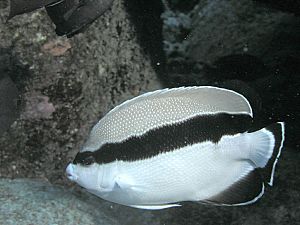Banded angelfish facts for kids
Quick facts for kids Banded angelfish |
|
|---|---|
 |
|
| Banded angelfish (Apolemichthys arcuatus ) | |
| Conservation status | |
| Scientific classification | |
| Synonyms | |
|
The banded angelfish (Apolemichthys arcuatus) is a unique and beautiful fish. It is also known as the bandit angelfish or three spine angelfish. This fish is a type of ray-finned fish. It belongs to the marine angelfish family, called Pomacanthidae. You can only find this fish in the deeper coral reefs around Hawaii and the Johnston Atoll.
Contents
What Does the Banded Angelfish Look Like?
The banded angelfish has a pale white body. It has a wide black band that stands out. This band has a white edge on its upper side. It starts right above the mouth and goes all the way to the back of the dorsal fin (the fin on its back).
Another black band, also with a white edge, runs along its tail fin (caudal fin) and its anal fin (the fin on its belly). The dorsal fin has 13 stiff spines and 17 or 18 soft rays. The anal fin has 3 spines and 18 soft rays. This fish can grow up to about 18 centimeters (7 inches) long.
Where Do Banded Angelfish Live?
The banded angelfish is found only in two places. These are Hawaii and the Johnston Atoll. This means it is "endemic" to these areas. You won't find it naturally anywhere else in the world.
Habitat and Daily Life
Banded angelfish are common on rocky reefs. They often hide under rocky overhangs and inside caves. They like areas where corals grow.
Their main food is sponges. But they also eat algae, small animals called hydroids, and the eggs of other sea creatures. You can find them at depths from about 10 meters (33 feet) down to 183 meters (600 feet). Younger angelfish usually live in deeper waters than the adults.
How the Banded Angelfish Got Its Name
The banded angelfish was first officially described in 1831. An English naturalist named John Edward Gray gave it the scientific name Holacanthus arcuatus. The word arcuatus means "bowed" or "arched." This name refers to the wide black band on its body. It looks like an arch from its eye to the end of its dorsal fin.
Banded Angelfish in Aquariums
It is rare to find the banded angelfish in the aquarium trade. If you do find one, it can be very hard to keep alive in a home aquarium. They need special care to survive outside their natural ocean home.
See also
 In Spanish: Apolemichthys arcuatus para niños
In Spanish: Apolemichthys arcuatus para niños


